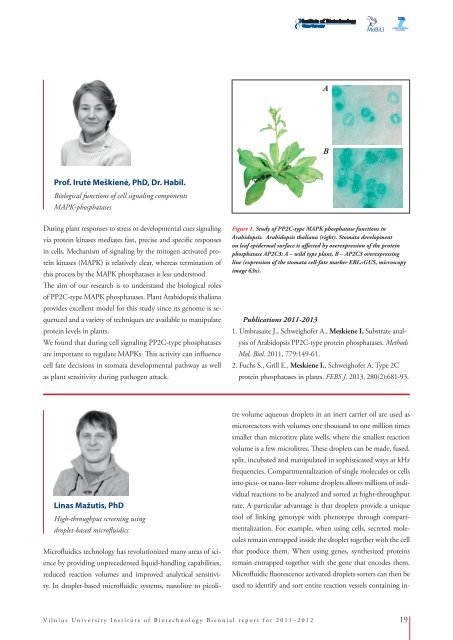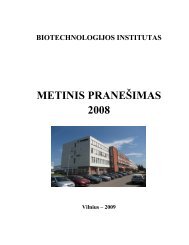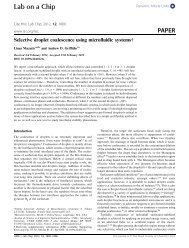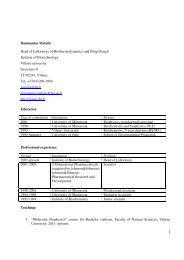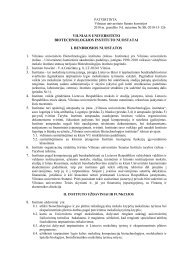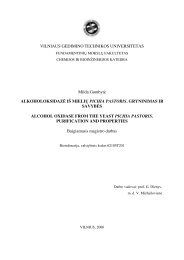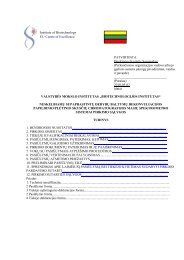Biennial Report 2011â2012
Biennial Report 2011â2012
Biennial Report 2011â2012
Create successful ePaper yourself
Turn your PDF publications into a flip-book with our unique Google optimized e-Paper software.
A<br />
B<br />
Prof. Irutė Meškienė, PhD, Dr. Habil.<br />
Biological functions of cell signaling components<br />
MAPK-phosphatases<br />
During plant responses to stress or developmental cues signaling<br />
via protein kinases mediates fast, precise and specific responses<br />
in cells. Mechanism of signaling by the mitogen activated protein<br />
kinases (MAPK) is relatively clear, whereas termination of<br />
this process by the MAPK phosphatases is less understood.<br />
The aim of our research is to understand the biological roles<br />
of PP2C-type MAPK phosphatases. Plant Arabidopsis thaliana<br />
provides excellent model for this study since its genome is sequenced<br />
and a variety of techniques are available to manipulate<br />
protein levels in plants.<br />
We found that during cell signaling PP2C-type phosphatases<br />
are important to regulate MAPKs. This activity can influence<br />
cell fate decisions in stomata developmental pathway as well<br />
as plant sensitivity during pathogen attack.<br />
Figure 1. Study of PP2C-type MAPK phosphatase functions in<br />
Arabidopsis. Arabidopsis thaliana (right). Stomata development<br />
on leaf epidermal surface is affected by overexpression of the protein<br />
phosphatase AP2C3: A – wild type plant, B – AP2C3 overexpressing<br />
line (expression of the stomata cell-fate marker ERL::GUS, microscopy<br />
image 63x).<br />
Publications 2011-2013<br />
1. Umbrasaite J., Schweighofer A., Meskiene I. Substrate analysis<br />
of Arabidopsis PP2C-type protein phosphatases. Methods<br />
Mol. Biol. 2011, 779:149-61.<br />
2. Fuchs S., Grill E., Meskiene I., Schweighofer A. Type 2C<br />
protein phosphatases in plants. FEBS J. 2013, 280(2):681-93.<br />
Linas Mažutis, PhD<br />
High-throughput screening using<br />
droplet-based microfluidics<br />
Microfluidics technology has revolutionized many areas of science<br />
by providing unprecedented liquid-handling capabilities,<br />
reduced reaction volumes and improved analytical sensitivity.<br />
In droplet-based microfluidic systems, nanolitre to picolitre<br />
volume aqueous droplets in an inert carrier oil are used as<br />
microreactors with volumes one thousand to one million times<br />
smaller than microtitre plate wells, where the smallest reaction<br />
volume is a few microlitres. These droplets can be made, fused,<br />
split, incubated and manipulated in sophisticated ways at kHz<br />
frequencies. Compartmentalization of single molecules or cells<br />
into pico- or nano-liter volume droplets allows millions of individual<br />
reactions to be analyzed and sorted at hight-throughput<br />
rate. A particular advantage is that droplets provide a unique<br />
tool of linking genotype with phenotype through compartmentalization.<br />
For example, when using cells, secreted molecules<br />
remain entrapped inside the droplet together with the cell<br />
that produce them. When using genes, synthesized proteins<br />
remain entrapped together with the gene that encodes them.<br />
Microfluidic fluorescence activated droplets sorters can then be<br />
used to identify and sort entire reaction vessels containing in-<br />
Vilnius University Institute of Biotechnology <strong>Biennial</strong> report for 2011–2012 19


